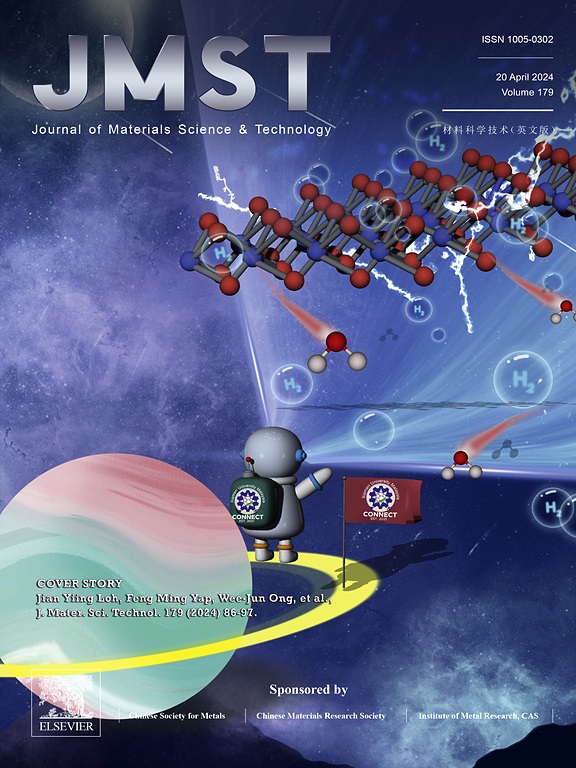Co31.5Fe18.5Ni31.5Al18.5共晶高熵合金滴铸与热机械加工的显微组织、力学性能及强化机理分析
IF 14.3
1区 材料科学
Q1 MATERIALS SCIENCE, MULTIDISCIPLINARY
引用次数: 0
摘要
滴铸Co31.5Fe18.5Ni31.5Al18.5共晶高熵合金(EHEA)的显微组织由两相共晶枝晶和共晶晶胞组成。在共晶晶胞内,两相共晶主要表现为NiAl相(BCC)和CoFeNi相(FCC)的片层结构。跌落铸造的Co31.5Fe18.5Ni31.5Al18.5 EHEA屈服强度为599±5 MPa,塑性为7.8%±0.4%。热机械加工,特别是冷轧退火(CRA),被用来提高滴铸EHEA的力学性能。经过CRA处理后,BCC相和FCC相均发生部分再结晶。值得注意的是,与BCC相相比,FCC相表现出更高程度的再结晶。因此,CRA EHEA被认为是一种双异质结构材料,在保持可接受的延展性(7.8%±0.3%)的同时,获得了高屈服强度(~ 1231±8 MPa)。随后的拉伸变形行为分析,包括断口形貌、侧面观察和变形亚结构,表明FCC相存在明显的塑性变形,而BCC相则表现出罕见的变形。随后,从两个不同的角度系统分析了强化机制。CRA EHEA的高强度主要表现为位错强化、析出强化、晶界强化和界面强化。其中,FCC单相特性的研究是新颖而有意义的,为理解FCC的强化机理提供了重要的见解。从另一个角度来看,CRA EHEA的高强度可归因于异质变形诱导(HDI)应力强化。综上所述,本文将为EHEAs的微观结构优化和力学性能的提高提供参考。本文章由计算机程序翻译,如有差异,请以英文原文为准。

Microstructure, mechanical property and strengthening mechanism analysis of drop-cast and thermo-mechanically processed Co31.5Fe18.5Ni31.5Al18.5 eutectic high-entropy alloy
The microstructure of drop-cast Co31.5Fe18.5Ni31.5Al18.5 eutectic high-entropy alloy (EHEA) consists of two-phase eutectic dendrites and eutectic cells. Within the eutectic dendrites/cells, the two-phase eutectic primarily displays a lamellar structure consisting of NiAl phase (BCC) and CoFeNi phase (FCC). The drop-cast Co31.5Fe18.5Ni31.5Al18.5 EHEA exhibits a moderate yield strength of 599 ± 5 MPa with an acceptable ductility of 7.8% ± 0.4%. Thermo-mechanical processing, specifically cold rolling and annealing (CRA), is employed to enhance the mechanical properties of the drop-cast EHEA. Following CRA treatment, partial recrystallization occurs within both the BCC and FCC phases. Notably, the FCC phase exhibits a higher degree of recrystallization compared to the BCC phase. Thus, the CRA EHEA is regarded as a dual heterostructured material, achieving a high yield strength of ∼1231±8 MPa while retaining acceptable ductility (7.8% ± 0.3%). Subsequent analysis of tensile deformation behavior, including fracture surface morphology, side-surface observations and deformation substructure, reveals pronounced plastic deformation in the FCC phase, while the BCC phase exhibits rare deformation. Subsequently, the strengthening mechanisms are systematically analyzed from two distinct perspectives. Firstly, the high strength of CRA EHEA is mainly attributed to dislocation strengthening, precipitation strengthening, grain-boundary strengthening and interface strengthening. In particular, the investigation of FCC individual phase property is novel and meaningful, providing critical insights into the understanding of the strengthening mechanism. From another perspective, the high strength of the CRA EHEA can be attributed to hetero-deformation-induced (HDI) stress strengthening. In conclusion, this paper will provide the implications for microstructural optimization and mechanical property improvement of EHEAs.
求助全文
通过发布文献求助,成功后即可免费获取论文全文。
去求助
来源期刊

Journal of Materials Science & Technology
工程技术-材料科学:综合
CiteScore
20.00
自引率
11.00%
发文量
995
审稿时长
13 days
期刊介绍:
Journal of Materials Science & Technology strives to promote global collaboration in the field of materials science and technology. It primarily publishes original research papers, invited review articles, letters, research notes, and summaries of scientific achievements. The journal covers a wide range of materials science and technology topics, including metallic materials, inorganic nonmetallic materials, and composite materials.
 求助内容:
求助内容: 应助结果提醒方式:
应助结果提醒方式:


